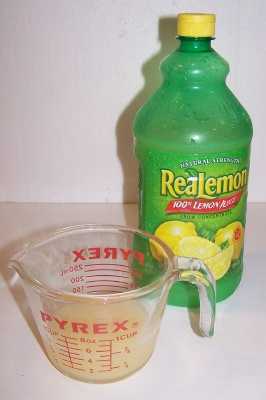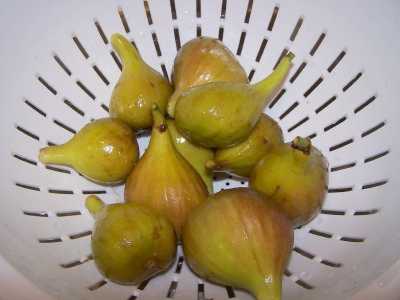
Looking for How to Make Homemade Canned Figs - Easily! With Step-by-step Photos, Recipe, Directions, Ingredients and Costs in 2025? Scroll down this page and follow the links. And if you bring home some fruit or vegetables and want to can, freeze, make jam, salsa or pickles, see this page for simple, reliable, illustrated canning, freezing or preserving directions. There are plenty of other related resources, click on the resources dropdown above. If you are having a hard time finding canning lids, I've used these, and they're a great price & ship in 2 days.
If you have questions or feedback, please let me know! There are affiliate links on this page. Read our disclosure policy to learn more.
How to Make Homemade Canned Figs - Easily! With Step-by-step Photos, Recipe, Directions, Ingredients and Costs
How to Make Home-canned Figs- Easily!
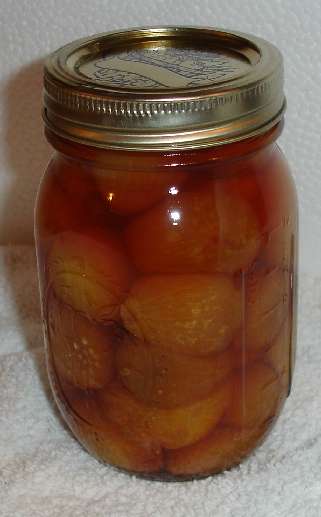 Making
and canning your own figs is also quite easy. Here's how to make it, in 12
easy steps and completely illustrated. These directions work equally well
for regular sugar, low sugar, fruit juice-sweetened and Stevia (in a prepared form like Truvia, it measures same as sugar; if you use another form, you will need do your own conversion) - or Splenda, if you prefer, -sweetened jam.
Making
and canning your own figs is also quite easy. Here's how to make it, in 12
easy steps and completely illustrated. These directions work equally well
for regular sugar, low sugar, fruit juice-sweetened and Stevia (in a prepared form like Truvia, it measures same as sugar; if you use another form, you will need do your own conversion) - or Splenda, if you prefer, -sweetened jam.
For more information about figs, see Fig Picking Tips. See How to Make Homemade Fig Preserves and Fig Jam and Making Candied figs and Other fig recipes. Also this page for Blueberry Jam directions, and for strawberry, blackberry, raspberry, peach, etc., and other types of jam, see this jam-making page!
For easy applesauce or apple butter directions, click on these links.
Ingredients and Equipment
|
Optional stuff:
|
Fig Canning Directions
This example shows you how to make canned (or bottled) jam; regular or with added seasoning. The yield from this recipe is about 7 pint jars.
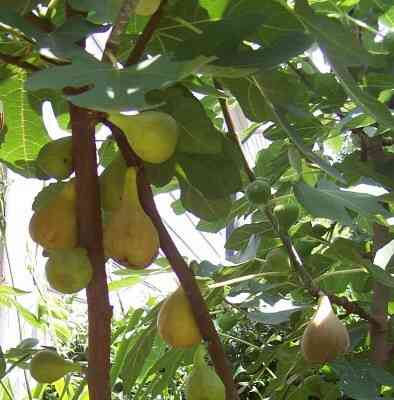 Step
1 - Pick the figs! (or buy them already picked)
Step
1 - Pick the figs! (or buy them already picked)
It's fun to go pick your own and you can obviously get better quality ones!
At right is a picture I took of figs from my own tree - these are a variety called Celeste - see this page for more information on various types of figs, how to select the variety and how to pick them!
To pick your own, here is a list and links to the pick your own farms. just select your area!
FYI, Figs are REALLY easy to grow and also make an attractive landscaping tree!
Step 2 - How much fruit?
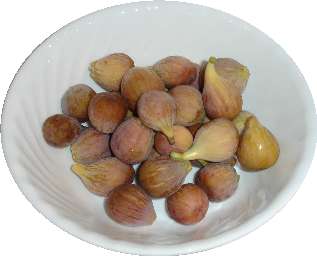 It
depends upon how much you want to make. I generally use pint jars for
canned figs. An average of 11 pounds is needed per canner load of 9
pints. That's about 4 dozen medium to large figs.
It
depends upon how much you want to make. I generally use pint jars for
canned figs. An average of 11 pounds is needed per canner load of 9
pints. That's about 4 dozen medium to large figs.
If you are using quart jars, an average of 16 pounds is needed per canner load of 7 quarts; An average of 2-1/2 pounds yields 1 quart of canned figs.
 Step
3 - Wash the jars and lids
Step
3 - Wash the jars and lids
Now's a good time to get the jars ready, so you won't be rushed later. The dishwasher is fine for the jars; especially if it has a "sanitize" cycle, the water bath processing will sanitize them as well as the contents! If you don't have a dishwasher with a sanitize cycle, you can wash the containers in hot, soapy water and rinse, then sanitize the jars by boiling them 10 minutes, and keep the jars in hot water until they are used.
NOTE: If a canning recipe calls for 10 minutes or more of process time in the canner, then the jars do not need to be "sanitized" before filling them. But really, sanitizing them first is just good hygeine and common sense! See this page for more detail about cleaning and sanitizing jars and lids.
Put the lids into a pan of hot, but not quite boiling water (that's what the manufacturer's recommend) for 10 minutes, and use the magnetic "lid lifter wand" to pull them out.
Leave the jars in the dishwasher on "heated dry" until you are ready to use them. Keeping them hot will prevent the jars from breaking when you fill them with the hot jam. Some newer dishwashers even have a "sanitize" setting.
Step 4 - Get the lids warming in hot (but not boiling) water
Lids: put the very hot (but not quite boiling; around 180 F, steaming
water is fine)
water (or on the stove in a pot of water on low heat) for
at least several minutes; to soften up the gummed surface and clean and
sanitize the lids.

 Need
lids, rings and replacement jars?
Need
lids, rings and replacement jars?
Get them all here, delivered direct to your home, at the best prices on the internet!
Step 5 -Wash the figs!
I'm sure you can figure out how to gently wash the fruit in plain cold water.
You should not cut off the stems or the bottom of the fig, nor peel them. You want them intact! Also, don't use overripe or nasty looking ones (example photo below)
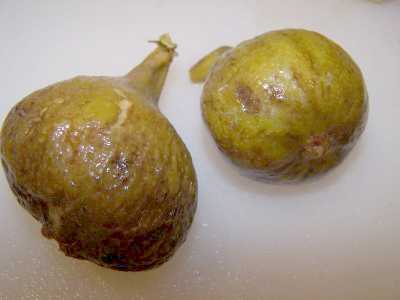
At left, sample figs with unappealing peels (skins).
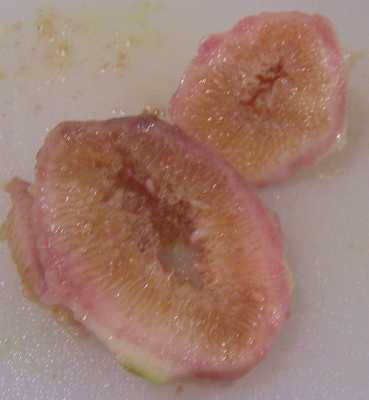
At right is a sample slice of a perfectly ripe but not over-ripe fig. It depends on the variety, but generally, they should be pink/yellowish and not brown inside....
Step 6 - Make the syrup
Depending upon which type of sweetener you want to use (sugar, no-sugar, Stevia (but you will have to experiment with amount, each brand of Stevia is a different concentration), or Splenda, or a mix of sugar and Stevia (or Splenda) or fruit juice) you will need to use a different syrup from below. Adding syrup to canned fruit helps to retain its flavor, color, and shape. It does not prevent spoilage of these foods. Heat the syrup to near boiling in a pot. Most people prefer the very light syrup!
|
Sugar syrup proportions for 7 to 9-pint jars of figs (double it for 9 quart jars) |
|||||
| Type of syrup (Choose ONE) |
Water (cups) |
Fruit juice (cups) |
Sugar (cups) |
Powdered Stevia (in a prepared form like Truvia, it measures same as sugar; if you use another form, you will need do your own conversion) - or Splenda, if you prefer it | |
|---|---|---|---|---|---|
| 1 | Plain water | 7 | 0 | 0 | 0 |
| 2 | no calorie sweetener | 7 | 0 | 0 | 1/4 cup |
| 3 | Fruit juice (white grape or peach juice works well) | 0 | 7 | 0 | |
| 4 | Reduce calorie / fruit juice | 4 | 3 | 0 | |
| 5 | Fruit juice and Stevia (in a prepared form like Truvia, it measures same as sugar; if you use another form, you will need do your own conversion) - or Splenda, if you prefer, | 0 | 7 | 0 | 1/2 cup |
| 6 | very low calorie | 7 | 0 | 1/4 | 1/4 cup |
| 7 | very light (10% sugar) | 7 | 0 | 1 | 0 |
| 8 | light (20% sugar) | 6 | 0 | 2 | 0 |
| 9 | medium (30% sugar) | 6 | 0 | 3 | 0 |
Step 7 - Blanching
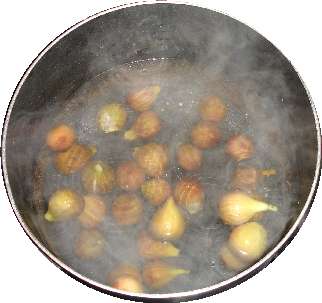 Put
the figs in a large pot of already boiling water (so all the figs are covered
with water) and boil 2 minutes. Quickly but gently remove the figs at 2 minutes
and drain.
Put
the figs in a large pot of already boiling water (so all the figs are covered
with water) and boil 2 minutes. Quickly but gently remove the figs at 2 minutes
and drain.
Step 8 - Boil the figs in the syrup
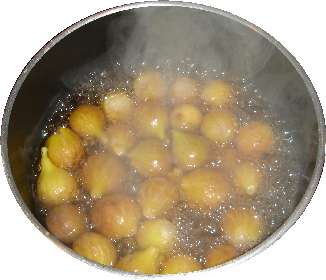 Gently
boil the figs in sugar or fruit juice or other syrup for 5 minutes.
Light syrup is generally preferred for taste!
Gently
boil the figs in sugar or fruit juice or other syrup for 5 minutes.
Light syrup is generally preferred for taste!
Notes:
- Nutrasweet (aspartame) will NOT work - it breaks down during heating).
- Stevia (in a prepared form like Truvia, it measures same as sugar; if you use another form, you will need do your own conversion) - or Splenda, if you prefer, (sucralose) substitutes with sugar BUT even the manufacturers of Splenda will tell you that you get best results if you just use a 50-50 mix; half regular sugar and half Splenda (or less of Stevia)
- Sugar not only affects the sweetness, but also the color and flavor. It does not affect the preserving or spoilage properties - that has to do with acid and the processing method.
- you can use "no sugar" pectin in place of "low sugar" pectin - you can still add sugar or other sweeteners.
Step 9 - Add the natural preservative
Add 2 tablespoons bottled lemon juice per quart jar or 1 tablespoon per pint jar to each of the jars. Alternatively, you may add 1/2 teaspoon citric acid (also goes under the brand name "fruit fresh") per quart or 1/4 teaspoon per pint to the jars. This is to increase the acidity and help prevent discoloration and spoilage.
Step 10 - Fill the jars with figs
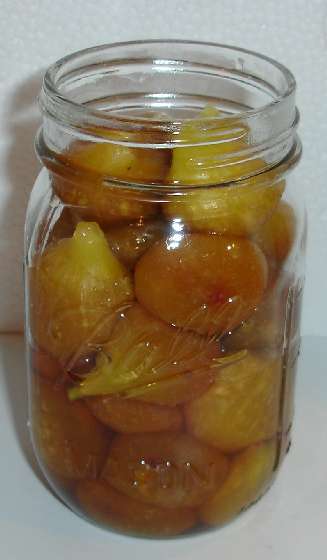 Fill
jars with hot figs, gently tapping the bottom of the jar on the
countertop to help pack the figs down gently (tapping does it without
breaking the figs)
Fill
jars with hot figs, gently tapping the bottom of the jar on the
countertop to help pack the figs down gently (tapping does it without
breaking the figs)
Step 11 - Fill the airspace in the jars with syrup
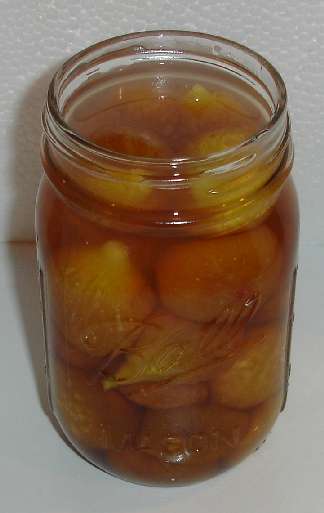 Add
the hot syrup (in which you heated the figs in step 8), leaving 1/4 to 1/2-inch
headspace. Wipe any spilled jam off the top,
Add
the hot syrup (in which you heated the figs in step 8), leaving 1/4 to 1/2-inch
headspace. Wipe any spilled jam off the top,
Step 12 - Put the lid /rings on and put in the canner
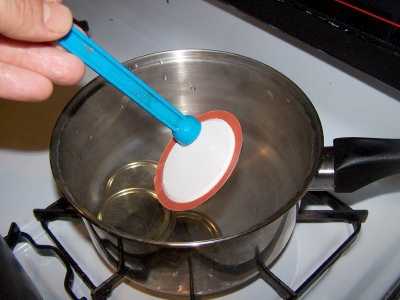 Seat
the lid and tighten the ring around them. This is where the jar
tongs and lid lifter come in really handy! Place them into the canner
Seat
the lid and tighten the ring around them. This is where the jar
tongs and lid lifter come in really handy! Place them into the canner
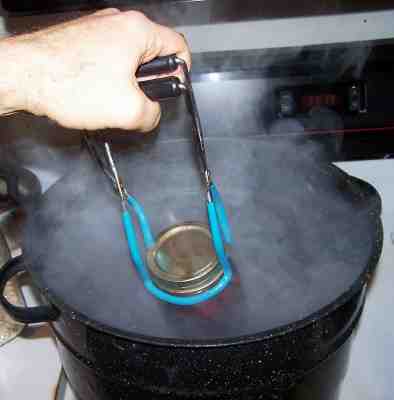 Step
13 - Process the jars in the boiling water bath
Step
13 - Process the jars in the boiling water bath
Keep the jars covered with at least 2 inches of water. Keep the water
boiling. In general, boil them for 45 minutes at sea level. I say "in
general" because you have to process (boil) them longer at higher altitudes
than sea level, or if you use larger jars, or if you did not
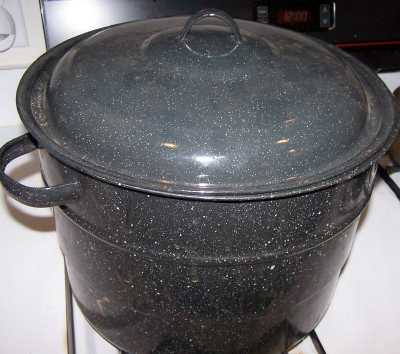 sanitize
the jars and lids right before using them.
sanitize
the jars and lids right before using them.
To adjust, process according to the recommendations in the table below:
| Table 1. Recommended process time for Figs in a boiling-water canner. | ||||
| Process Time at Altitudes of | ||||
| Jar Size | 0 - 1,000 ft | 1,001 - 3,000 ft | 3,001 - 6,000 ft | Above 6,000 ft |
| Pints | 45 min | 50 | 55 | 60 |
| Quarts | 50 | 55 | 60 | 65 |
Step 14 - Remove and cool the jars - Done!
 Lift
the jars out of the water and let them cool without touching or bumping
them in a draft-free place (usually takes overnight) You can then remove
the rings if you like, but if you leave them on, at least loosen them
quite a bit, so they don't rust in place due to trapped moisture. Once
the jars are cool, you can check that they are sealed verifying that the
lid has been sucked down. Just press in the center, gently, with your
finger. If it pops up and down (often making a popping sound), it is not
sealed. If you put the jar in the refrigerator right away, you can still
use it. Some people replace the lid and reprocess the jar, then that's a
bit iffy. If you heat the contents back up, re-jar them (with a new lid)
and the full time in the canner, it's usually ok.
Lift
the jars out of the water and let them cool without touching or bumping
them in a draft-free place (usually takes overnight) You can then remove
the rings if you like, but if you leave them on, at least loosen them
quite a bit, so they don't rust in place due to trapped moisture. Once
the jars are cool, you can check that they are sealed verifying that the
lid has been sucked down. Just press in the center, gently, with your
finger. If it pops up and down (often making a popping sound), it is not
sealed. If you put the jar in the refrigerator right away, you can still
use it. Some people replace the lid and reprocess the jar, then that's a
bit iffy. If you heat the contents back up, re-jar them (with a new lid)
and the full time in the canner, it's usually ok.
Once cooled, they're ready to store. I find they last about 18 months. After that, the get darker in color and start to get runny. They still seem safe to eat, but the flavor is bland. So eat them in the first 12 to 18 months after you prepare them!
Other Equipment:From left to right:
|
 You can get all of the tools in a kit here: See here for related tools, equipment, supplies on Amazon |
Summary - Cost of Making Home Canned Figs - makes 7 pint jars, 16 oz each** |
||||
| Item | Quantity | Cost in 2025 | Source | Subtotal |
| Figs | 11 lbs (about 2 gallon, or 4 dozen large figs) | $10.00/gallon | Pick your own | $10.00 |
| Canning jars (8 oz size), includes lids and rings | 7 jars | $11/dozen 8 oz jars or $0.92/jar |
Grocery stores, like Public, Kroger, Safeway and sometimes, Big Lots, local hardware stores and big box stores | $7.50 |
| Sugar | 1 cup | $0.50 | Grocery stores, like Public, Kroger, Safeway and sometimes, Big Lots, local hardware stores and big box stores | $0.50 |
| Total | $18.00 total or about $2.55 per pint jar |
|||
|
* - This assumes you already have the pots, pans, ladles,, and reusable equipment. Note that you can reuse the jars! If you already have jars or reuse them, just buy new lids (the rings are reusable, but the flat lids are not)! |
||||
Can't find the equipment? We ship to all 50 states!
Use our Feedback form!
Answers to Common Questions
Comments and Feedback
|
Looking for canning equipment and supplies?
Water bath canner with a jar rack
Pressure canners for gas, electric and induction stoves: Presto 23Qt or T-fal 22Qt
Canning scoop (this one is PERFECT)
Ball Blue book (most recent version)
Jars: 8oz canning jars for jams
Find Other types of farms:
Farm markets and roadside stands
Road trips and camping resources
Local Honey, apiaries, beekeepers
Consumer fraud and scams information
Home canning supplies at the best prices on the internet!
Maple Syrup Farms, sugarworks, maple syrup festivals
Environmental information and resources
Farms For Your Event for birthday parties, weddings, receptions, business meetings, retreats, etc.
Festivals - local fruit and vegetable festivals
Get the
most recent version of
the Ball Blue Book
With this Presto 23 quart pressure canner and pressure cooker, you can "can" everything, fruits, vegetables, jams, jellies, salsa, applesauce, pickles, even meats, soups, stews. Model 01781

You can make jams, jellies, can fruit, applesauce, salsa and pickles with water bath canners, like this Granite Ware 12-Piece Canner Kit, Jar Rack, Blancher, Colander and 5 piece Canning Tool Set

